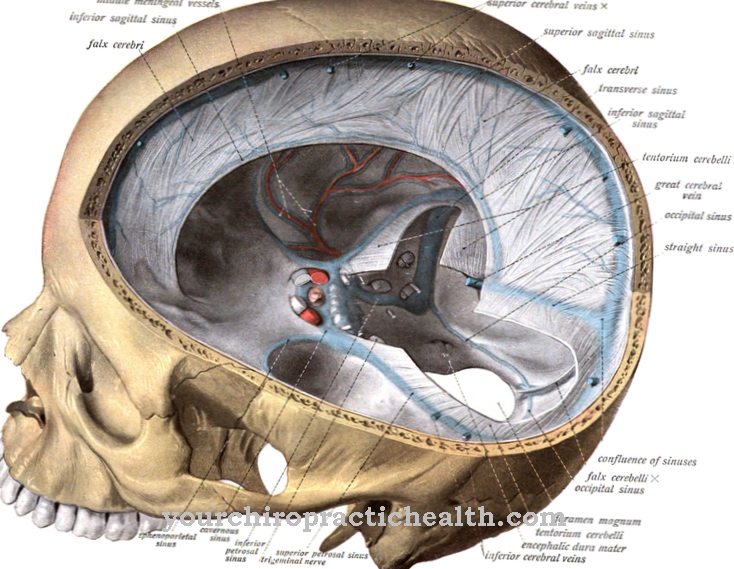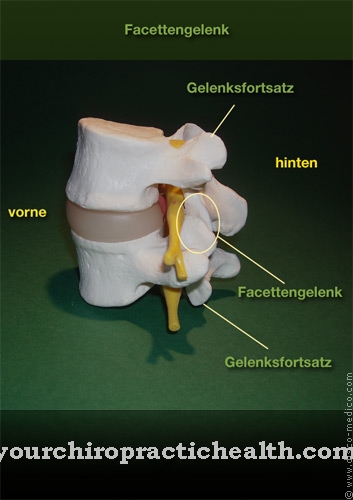Of the Transversus colli nerve is a purely sensitive nerve in the neck and chest region.It arises from the spinal cord segments C1 and C2. Damage to the nerve or spinal cord can lead to a complete loss of skin sensations in the corresponding area.
What is the transversus colli nerve?
Depending on how many sensitive and how many motor fibers a nerve contains, it is referred to as a motor, sensory or mixed nerve. The transversus colli nerve is a sensitive nerve. This is the transverse cervical nerve, which only contains sensitive fibers and is therefore used for the afferent conduction of stimulus information. Afferent in this context means that the nerve carries information from the body's periphery into the central nervous system.
The transversus colli nerve is a sensitive branch of the superior cervical plexus. This mixed plexus is also known as the cervical plexus. As a sensitive branch of the plexus, the nerve arises directly from the spinal cord and comes from segments C1 and C2.
The nerve is involved in the sensitive supply of the skin in the area of the throat. Its coverage area extends from the neck to the sternum. In its course, the transversus colli nerve divides into anterior and posterior branches, with all branches corresponding to purely sensory nerve branches. The second and third spinal nerves are the starting points of the nerve.
Anatomy & structure
The transverus colli nerve winds around the sternocleidomastoid muscle. In the punctum nervosum or Erb's point, the nerve appears together with the nervi supraclaviculares, the nervus occipitalis minor and auricularis magnus at the posterior edge of the muscle, from where it runs anteriorly and crosses the sternocleidomastoid muscle towards the anterior edge. It goes under the external jugular vein in order to pierce the superficial neck fascia.
Under the platysmas the sensitive nerve becomes smaller branches with a mixed ascending and descending course. These branches are distributed in the laterally anterior neck region. The ascending branches are called the rami superiores and run towards the lower jaw, where, together with the ramus colli from the facial nerve, they become a nerve loop under the platysma, known as the ansa cervicalis superficialis.
The Nevus transverus colli pierces the platysma with a few fibers and is thus finely ramified in the anterior upper neck region. The descending branches of the nerve are called the rami inferiores and penetrate the platysma to distribute themselves in the skin of the anterior sub-neck region.
Function & tasks
Like all sensory nerves, the sensory fibers of the nervus transversus fully conduct sensations or stimuli that are registered by so-called receptors. Receptors are sensory cells used to perceive pain, temperature and touch. From a certain stimulus strength onwards, the receptors form what is known as an action potential and thus translate the sensation into the language of the central nervous system. The fibers of the transversus colli nerve receive this signal and act as a conduit. Like a cable, they conduct the registered stimuli from the neck and chest region towards the central nervous system.
Depending on the direction of their conduction of excitation, we also speak of afferent fibers. All branches of the transversus colli nerve consist exclusively of afferent fibers, since the nerve is an exclusively sensory nerve. In the German-speaking world, sensory nerve branches are differentiated from sensory fibers. Instead of conducting the excitation of sensory organs such as eyes, ears or nose, like sensory fibers, sensitive nerves such as the transversus colli nerve are not necessarily involved in the conduction of stimuli in the sensory organs. Since sensitive fibers also contain specialized nerve endings for receiving stimuli, this distinction has not become common in other languages.
In contrast to motor nerves, purely sensory nerves actually only contain sensory fibers. Motor nerves also contain parts of sensitive fibers that transmit stimuli such as muscle tone to the central nervous system. The nervus transversus colli does not transmit sensations from the muscles or information about the muscle tone in the neck and chest area, since the sensitive parts of the nerves supplying the motor are used for this.
You can find your medication here
➔ Medicines for paresthesia and circulatory disordersDiseases
Nerve diseases such as polyneuropathy can cause lesions on the transversus colli nerve. Such lesions lead to discomfort in the chest and neck area or even complete loss of skin sensations. In polyneuropathies, only peripheral nerves are affected by damage. The neurogenic diseases are often associated with previous poisoning, a metabolic disorder such as diabetes or vitamin deficiency.
Myelin coats the nerve fibers to ensure their conductivity. In polyneuropathies, however, the myelin around peripheral nerves degenerates so that existing stimuli are no longer sent to the central nervous system, only with a delay or with qualitative impairment. Parasitic sensations due to demyelination processes include numbness, tingling sensations or impaired sensation of hot and cold.
The nervus transversus colli also causes complaints after damage to the spinal cord and thus the central nervous system. Line failures or disturbed sensations of irritation occur in this nerve mainly after damage to the spinal cord segments C1 and C2, the fibers of which the sensitive nerve contains. Such damage to the spinal cord can be traumatic, but it can also occur as a result of tumors, inflammatory processes and spinal cord infarctions.
The most common inflammations of the spinal cord include the autoimmune inflammations associated with multiple sclerosis. Nerve compression syndromes can also limit the conductivity of the transversus colli nerve. In these compression syndromes, the nerve becomes jammed in an anatomical constriction. Often an entire nerve network is affected by such blockages. In the transversus colli nerve, this superordinate network would be the cervical plexus.

























.jpg)

.jpg)
